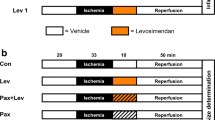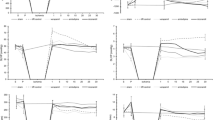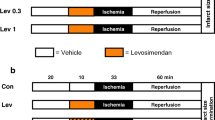Abstract
The objective of this study is to assess the participation of mitochondrial ATP-sensitive potassium (mitoKATP) channels in the cardioprotective effects of the Na+/H+ exchanger (NHE-1) blocker cariporide in isolated rat hearts. Regional ischemia was induced by occlusion of left anterior descending coronary artery during 40 min followed by 2-h reperfusion (IC). Cariporide (C, 10 μΜ), or C plus 5-hydroxydecanoate (5-HD, 100 μM, a selective mitoKATP channel inhibitor), or C plus chelerythrine (Chele, 1 μM, a PKC inhibitor), or an opener of mitoKATP channels, diazoxide (Dz, 100 μM) was applied at the onset of reperfusion. Infarct size (IS) and myocardial function were evaluated. The calcium-induced permeability transition pore (mPTP) opening was determined by measuring the light scattering decrease (LSD, a.u.) in isolated mitochondria in the absence and presence of C, C + 5-HD and Dz. IS was 33 ± 2% of the risk area in IC and was significantly diminished by C (15 ± 2%, p < 0.05), which also improved myocardial function [LVDP = 58 ± 5% (IC) vs 80 ± 5% (C)] and blunted LSD [0.80 ± 0.04 (IC) vs 0.51 ± 0.04 (C) a.u.]. 5-HD and Chele were both able to abolish the cardioprotective effects of C on IS. Dz treatment decreased IS and LSD to a similar extent to that produced by C (15 ± 4% and 0.52 ± 0.04 a.u., respectively). The present data suggest that attenuation of mPTP opening after PKC-mediated mitoKATP channel activation is a crucial step for the cardioprotective effects of cariporide.







Similar content being viewed by others
References
Allen DG, Cairns SP, Turvey SE, Lee JA (1993) Intracellular calcium and myocardial function during ischemia. Adv Exp Med Biol 346:19–29
Ambrosio G, Flaherty JT, Duilio C, Tritto I, Santoro G, Elia PP, Condorelli M, Chiariello M (1991) Oxygen radicals generated at reflow induce peroxidation of membrane lipids in reperfused hearts. J Clin Invest 87:2056–2066
An J, Varadarajan SG, Camara A, Chen Q, Novalija E, Gross GJ, Stowe DF (2001) Blocking Na+/H+ exchange reduces [Na+]i and [Ca2+]i load after ischemia and improves function in intact hearts. Am J Physiol Heart Circ Physiol 281:H2398–H2409
Baines CP, Song CX, Zheng YT, Wang GW, Zhang J, Wang OL, Guo Y, Bolli R, Cardwell EM, Ping P (2003) Protein kinase C epsilon interacts with and inhibits the permeability transition pore in cardiac mitochondria. Circ Res 92(8):873–880
Bolli R, Jeroudi MO, Patel BS, Hartley CJ, Thornby JI, Roberts R (1989) Direct evidence that oxygen-derived free radicals contribute to postischemic myocardial dysfunction in the intact dog. Proc Natl Acad Sci 86:4695–4699
Bradford MM (1976) A rapid and sensitive for the quantitation of microgram quantitites of protein utilizing the principle of protein-dye binding. Anal Biochem 72:248–254
Buege JA, Aust SD (1978) Microsomal lipid peroxidation. Methods Enzymol 52:302–309
Costa ADT, Garlid KD (2008) Intramitochondrial signaling: interactions among mitoKATP, PKC, ROS, and MPT. Am J Physiol Heart Circ Physiol 295(2):H874–H882
Crompton M (1999) The mitochondrial transition pore and its role in cell death. Biochem J 341:233–249
Das B, Sarkar C (2003) Mitochondrial KATP channel activation is important in the antiarrhythmic and cardioprotective effects of non-hypotensive doses of nicorandil and cromakalim during ischemia/reperfusion: a study in an intact anesthetized rabbit model. Pharmacol Res 47:447–461
Facundo HT, de Paula JG, Kowaltowski AJ (2007) Mitochondrial ATP-sensitive K+ channels are redox-sensitive pathways that control reactive oxygen species production. Free Radic Biol Med 42(7):1039–1048
Fantinelli JC, Cingolani HE, Mosca SM (2006) Na+/H+ exchanger inhibition at the onset of reperfusion decreases the myocardial infarct size: role of ROS. Cardiovasc Pathol 15(4):179–184
Garciarena CD, Caldiz CI, Correa MV, Schinella GR, Mosca SM, Chiappe de Cingolani GE, Cingolani HE, Ennis IL (2008) Na+/H+ exchanger-1 inhibitors decrease myocardial superoxide production via direct mitochondrial action. J Appl Physiol 105:1706–1713
Garciarena CD, Fantinelli JC, Caldiz CI, Chiappe de Cingolani G, Ennis IL, Pérez NG, Cingolani HE, Mosca SM (2011) Myocardial reperfusion injury: reactive oxygen species vs. NHE-1 reactivation. Cell Physiol Biochem, in press
Green DR, Kroemer G (2004) The pathophysiology of mitochondrial cell death. Science 305:626–629
Gumina RJ, Mizumura T, Beier N, Schelling P, Schultz JJ, Gross GJ (1998) A new sodium/hydrogen exchange inhibitor, EMD 85131, limits infarct size in dogs when administered before and after coronary occlusion. J Pharmacol Exp Ther 286:175–183
Hale SL, Kloner RA (2000) Effect of combined KATP channel activation and Na+/H+ exchange inhibition on infarct size in rabbits. Am J Physiol Heart Circ Physiol 279(6):H2673–H2677
Halestrap AP, Kerr PM, Javadov S, Woodfield KY (1998) Elucidating the molecular mechanism of the permeability transition pore and its role in reperfusion injury of the heart. Biochim Biophys Acta 1366:79–94
Hendrikx M, Mubagwa K, Verdonck F, Overloop K, Van Hecke P, Vanstapel F, Van Lommel A, Verbeken E, Lauweryns J, Flameng W (1994) New Na+/H+ exchange inhibitor HOE 694 improves postischemic function and high-energy phosphate resynthesis and reduces Ca2+ overload in isolated perfused rabbit heart. Circulation 89:2787–2798
Hotta Y, Ishikawa N, Ohashi N, Matsui K (2001) Effects of SM-20550, a selective Na+-H+ exchange inhibitor, on the ion transport of myocardial mitochondria. Mol Cell Biochem 219:83–90
Hurtado C, Pierce GN (2000) Inhibition of Na+/H+ exchange at the beginning of reperfusion is cardioprotective in isolated, beating adult cardiomyocytes. J Mol Cell Cardiol 32:1897–1907
Javadov S, Choi A, Rajapurohitam V, Zeidan A, Basnakian AG, Karmazyn M (2008) NHE-1 inhibition-induced cardioprotection against ischaemia/reperfusion is associated with attenuation of the mitochondrial permeability transition. Cardiovasc Res 77:416–424
Kapus A, Lukacs GL, Cragoe EJ Jr, Ligeti E, Fonyo A (1988) Characterization of the mitochondrial Na+-H+ exchange. The effect of amiloride analogues. Biochim Biophys Acta 944:383–390
Klein HH, Pich S, Bohle RM, Lindert-Heimberg S, Nebendahl K (2000) Na+/H+ exchanger inhibitor cariporide attenuates cell injury predominantly during ischemia and not at the onset of reperfusion in porcine hearts with low residual blood flow. Circulation 102:1977–1982
Lazdunski M, Frelin C, Vigne P (1985) The sodium/hydrogen exchange system in cardiac cells: its biochemical and pharmacological properties and its role in regulating internal concentrations of sodium and internal pH. J Mol Cell Cardiol 17(11):1029–1042
Lesnefsky EJ, Moghaddas S, Tandler B, Kerner J, Hoppel CL (2001) Mitochondrial dysfunction in cardiac disease: ischemia–reperfusion, aging, and heart failure. J Mol Cell Cardiol 33:1065–1089
Mason RB, Pluta RM, Walbridge S, Wink DA, Oldfield EH, Boock RJ (2000) Production of reactive oxygen species after reperfusion in vitro and in vivo: protective effect of nitric oxide. J Neurosurg 93:99–107
Matsumoto T, Miura T, Miki T, Nishino Y, Nakamura Y, Shimamoto K (2003) Does enhanced expression of the Na+-Ca2+ exchanger increase myocardial vulnerability to ischemia/reperfusion injury in rabbit hearts? Mol Cell Biochem 248(1–2):141–147
Mela L, Seitz S (1979) Isolation of mitochondria with emphasis on heart mitochondria from small amounts of tissue. Methods Enzymol 55:39–46
Miura T, Liu Y, Goto M, Tsuchida A, Miki T, Nakano A, Nishino Y, Ohnuma Y, Shimamoto K (2001) Mitochondrial ATP-sensitive K+ channels play a role in cardioprotection by Na+-H+ exchange inhibition against ischemia/reperfusion injury. J Am Coll Cardiol 37:957–963
Molavi B, Mehta JL (2004) Oxidative stress in cardiovascular disease: molecular basis of its deleterious effects, its detection, and therapeutic considerations. Curr Opin Cardiol 19:488–493
Mosca SM, Cingolani HE (2000) Comparison of the protective effects of ischemic preconditioning and the Na+/H+ exchanger blockade. Naunyn Schmiedeberg’s Arch Pharmacol 362:7–13
Murphy E, Steenbergen C (2008) Mechanisms underlying acute protection from cardiac ischemia-reperfusion injury. Physiol Rev 88:581–609
Pain T, Yang XM, Critz SD, Yue Y, Nakano A, Liu GS, Heusch G, Cohen MV, Downey JM (2000) Opening of mitochondrial KATP channels triggers the preconditioning state by generating free radicals. Circ Res 87:460–466
Penna C, Rastaldo R, Mancardi D, Raimondo S, Cappello S, Gattullo D, Losano G, Pagliaro P (2006) Post-conditioning induced cardioprotection requires signaling through a redox-sensitive mechanism, mitochondrial ATP-sensitive K+ channel and protein kinase C activation. Basic Res Cardiol 101(2):180–189
Ruiz-Meana M, Garcia-Dorado D, Pina P, Inserte J, Agullo L, Soler-Soler J (2003) Cariporide preserves mitochondrial proton gradient and delays ATP depletion in cardiomyocytes during ischemic conditions. Am J Physiol Heart Circ Physiol 285:H999–H1006
Sato T, O’Rourke B, Marban E (1998) Modulation of mitochondrial ATP-dependent K+ channels by protein kinase C. Circ Res 83:110–114
Scholz W, Albus U, Counillon L, Gögelein H, Lang HJ, Linz W, Weichert A, Schölkens BA (1995) Protective effects of HOE 642, a selective sodium-hydrogen exchange subtype 1 inhibitor, on cardiac ischaemia and reperfusion. Cardiovasc Res 29:260–268
Shen AC, Jennings RB (1972) Kinetics of calcium accumulation in acute myocardial ischemic injury. Am J Pathol 67(3):441–452
Suzuki M, Sasaki N, Miki T, Sakamoto N, Ohmoto-Sekine Y, Tamagawa M, Seino S, Marbán E, Nakaya H (2002) Role of sarcolemmal KATP channels in cardioprotection against ischemia/reperfusion injury in mice. J Clin Invest 109:509–516
Tsujii E, Tanaka H, Oyamada M, Fujita K, Hamamoto T, Takamatsu T (2003) In situ visualization of the intracellular Ca2+ dynamics at the border of the acute myocardial infarct. Mol Cell Biochem 248(1–2):135–139
Vivaldi MT, Kloner RA, Schoen FJ (1985) Triphenyltetrazolium staining of irreversible injury following coronary artery occlusion in rats. Am J Pathol 121:522–530
Wang Y, Ashraf M (1999) Role of protein kinase C in mitochondrial KATP channel-mediated protection against Ca2+ overload injury in rat myocardium. Circ Res 84(10):1156–1165
Xiao XH, Allen DG (2000) Activity of the Na+/H+ exchanger is critical to reperfusion damage and preconditioning in the isolated rat heart. Cardiovasc Res 48:244–253
Xiao XH, Allen DG (2003) The cardioprotective effects of Na+/H+ exchange inhibition and mitochondrial KATP channel activation are additive in the isolated rat heart. Pflugers Arch 447(3):272–279
Zhao Z-Q, Corvera JS, Halkos ME, Kerendi F, Wang NP, Guyton RA, Vinten-Johansen J (2003) Inhibition of myocardial injury by ischemic postconditioning during reperfusion: comparison with ischemic preconditioning. Am J Physiol Heart Circ Physiol 285:H579–H588
Zweier JL (1988) Measurement of superoxide-derived free radicals in the reperfused heart. Evidence for a free radical mechanism of reperfusion injury. J Biol Chem 263:1353–1357
Acknowledgments
This work was supported in part by the grant PICT 1046 from Agencia Nacional de Promoción Científica y Técnica of Argentina to Dr Susana M Mosca.
Author information
Authors and Affiliations
Corresponding author
Rights and permissions
About this article
Cite this article
Nuñez, I.P., Fantinelli, J., Arbeláez, L.F.G. et al. Mitochondrial KATP channels participate in the limitation of infarct size by cariporide. Naunyn-Schmiedeberg's Arch Pharmacol 383, 563–571 (2011). https://doi.org/10.1007/s00210-011-0632-z
Received:
Accepted:
Published:
Issue Date:
DOI: https://doi.org/10.1007/s00210-011-0632-z




